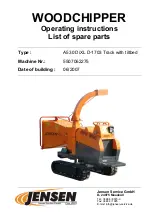
12.2.7 - Low-temperature brine solution option
Glycol/water mix production from 0°C to -8°C is only possible
with the low-temperature glycol/water mix option.
The unit is equipped with insulation on the suction pipes. The
insulation is reinforced on the low-temperature brine solution
option.
The operating range depends on:
-
the unit size,
-
the glycol type,
-
its concentration,
-
the flow rate,
-
the temperature of the glycol solution,
-
the condensing pressure (ambient temperature).
12.2.7.1 - Frost protection
The low-pressure and frost protection thresholds of the
evaporator depend on the antifreeze level in the water loop.
The evaporator pinch (LWT – SST) and the antifreeze protection
threshold depend on this level.
It is therefore essential, when first activating the unit, to check
the antifreeze level in the loop (circulate for 30 minutes to ensure
good mixing homogeneity before sampling).
Refer to the manufacturer or supplier data to define the freezing
temperature according to the measured concentration level.
The minimum frost protection temperature must be entered in
the unit controller's parameters.
This value will be used to configure the following protection:
1. Evaporator antifreeze protection.
2. Low-pressure protection.
For information, for the different antifreezes used in our
laboratory, the protection values given by our supplier are as
follows (these values may change depending on the suppliers).
12.2.7.2 - Glycol concentration required
Ethylene and Propylene glycol freezing curve
Glycol concentration (%)
Minimum frost protection temperature (°C)
Ethylene glycol (%)
Propylene glycol (%)
12.2.7.3 - Minimum frost protection temperature to be
observed based on the leaving water temperature.
Minimum frost protection temperature based on the
leaving water temperature (example)
Minimum frost protection
temperature (°C)
Leaving water temperature (°C)
For example, based on the above curves, if the ethylene glycol
mass concentration measured in the loop is 30%, the frost
protection temperature value of -14.8°C must be entered in the
software. This corresponds to a minimum leaving water
temperature of -6.7°C. The control point must be adjusted as a
result.
IMPORTANT:
-
It is vital to perform a (minimum) annual inspection of the
glycol level and adjust the software's frost protection based
on the measured level.
-
This procedure must be systematic when topping up with
water or antifreeze solution.
-
Observe the minimum frost protection temperature based on
the leaving water temperature.
NOTE:
-
In the case of frost protection of the unit by low air temperature,
the percentage of glycol must be evaluated accordingly.
-
The maximum glycol level in the case of units equipped with
a hydronic module is 45%.
-
In order to facilitate maintenance operations, it is recommended
to install isolation valves upstream and downstream of the
machine
12.2.8 - Units with available pressure fans
Ductable units are intended to be ducted on the fan discharge,
and can be installed inside a machine room.
For this type of installation, the hot or cold air emerging from the
air-cooled exchangers is evacuated from the building by the fans
by means of a ductwork system, which causes pressure drops
in the air circuit.
Installing a ductwork system on the fan discharge generated a
pressure drop due to the air flow resistance.
For each installation, the duct pressure drops differ, depending
on the duct length, the duct section and the direction changes.
Therefore, more powerful fan motors are installed in this option
than on the standard units.
Ductable units equipped with this option are designed to operate
with ducts whose air evacuation generates a maximum pressure
drop of 200 Pa.
Using a speed variation up to 19 rps enables the system to
overcome the pressure drops in the ducts while maintaining an
optimised air flow in each circuit.
All the fans in the same circuit run at the same time at the same
speed.
In the cooling / heating mode, the full-load or part-load speed is
controlled by a patented algorithm that permanently optimizes
the condensing / evaporating temperature to ensure the best
unit energy efficiency (EER / COP) whatever the operating
conditions and pressure drop of the system ductwork.
12 - OPTIONS
EN-61
AQUACIAT
POWER
ILD












































